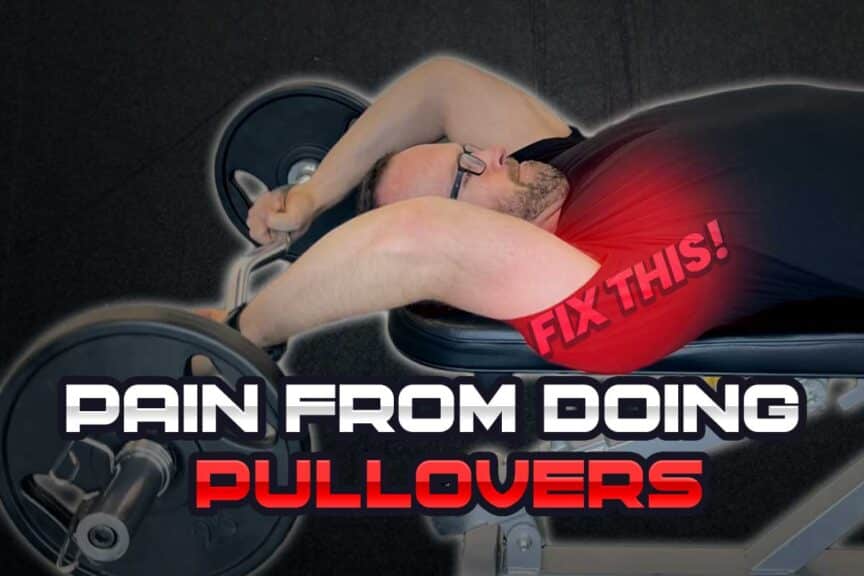I’m going to go to my grave believing that not enough people incorporate pullovers into their strength training regimens. The pullover’s benefits are too profound to ignore, as few upper body exercises offer the simultaneous strengthening and lengthening benefits to the muscles the way this exercise does.
But if you’re getting pain with this exercise, it’s easy to understand why you might not want to do this movement. So, this article will provide the requisite information that will hopefully help you to change all of that.
Dumbbell and barbell pullover pain is often the result of poor scapular and shoulder mechanics, tight or restricted muscular tissue, poor exercise technique, and excessively heavy loads. Solutions involve fixing shoulder mechanics, improving mobility, and perfect execution of the pullover exercise.
Assuming you want to be as bulletproof and informed with your lifting as possible, keep on reading to learn just how easy it often is to eliminate pain or abnormal discomfort when doing your pullovers.
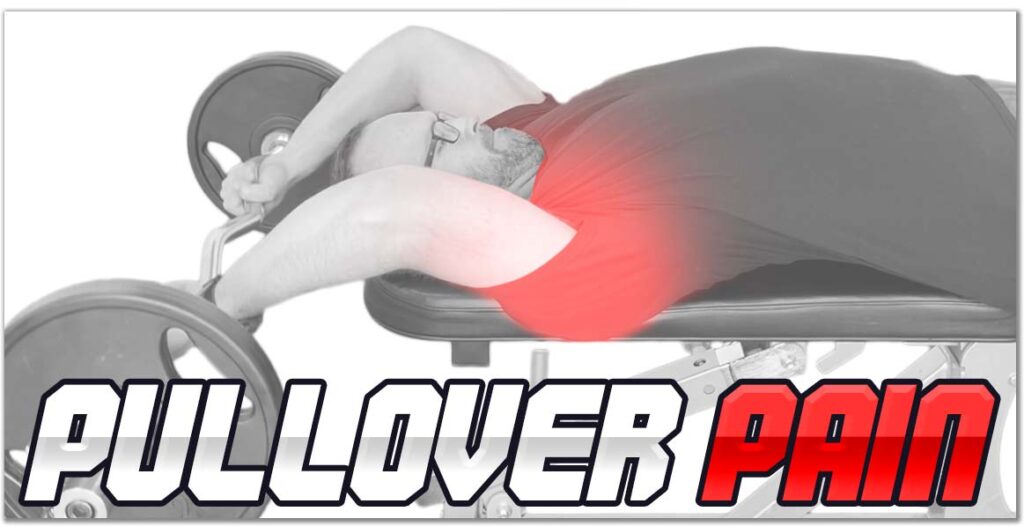
ARTICLE OVERVIEW (Quick Links)
Click/tap on any headline below to instantly read that section!)
Issue 1: Poor tissue mobility
Issue 2: Poor scapular mechanics
Issue 3: Using Excessive range
Issue 4: Excessive resistance
Bonus tip: Previous injury
Related article: Here’s How to Fix Shoulder Pain From Dips (Complete Guide)
Disclaimer: While I am a physical therapist, I am not YOUR physical therapist. As a result, I cannot tell you whether or not any treatments or training methodologies mentioned on this website or in this article may or may not be appropriate for you, including dealing with pain from pullovers. By following any information within this post, you are doing so at your own risk. You are advised to seek appropriate medical advice for any pain you may be experiencing.
As we kick off this article, keep in mind that these common issues, which can result in pain, discomfort, and even lost training time, can arise whether you’re performing your pullovers with a barbell, a single dumbbell, or even a dumbbell in each hand.
Also, keep in mind that I can’t address every single issue that could arise with this exercise. There can be issues with your AC joint, subacromial bursa, etc. So, your best bet — if you just can’t get the issue under control — is to get an evaluation from a qualified healthcare practitioner, such as an orthopedic physical therapist.
Nonetheless, what follows are some of the most common issues that can arise and how to get them under control!
Issue 1: Poor tissue mobility of the upper body
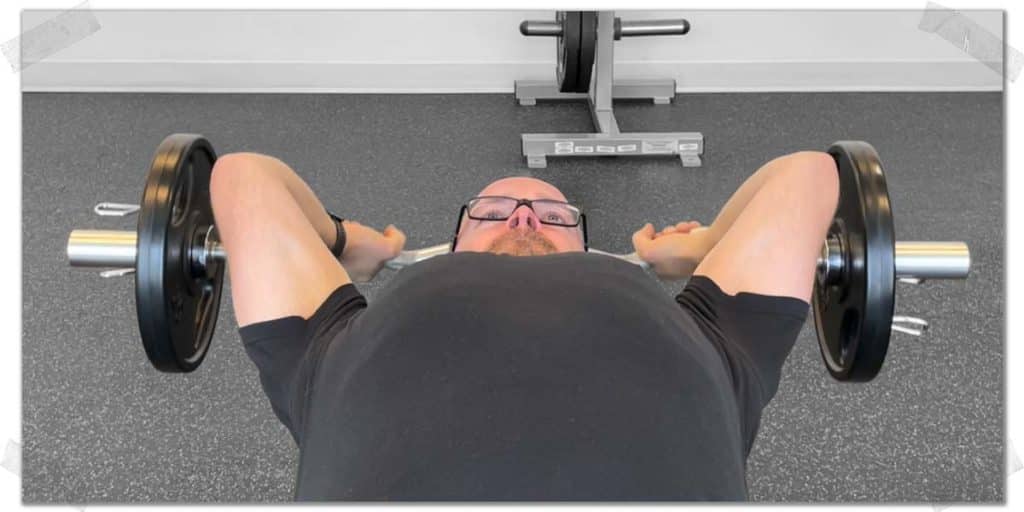
One of the beautiful aspects of the pullover is its ability to improve the tissue mobility of your pecs, triceps, and lats along with strengthening them; it’s essentially a “strengthen and lengthen” exercise.
But the pullover can feel anything but beneficial to your body if the mobility of your muscles, joints (or both) is currently subpar. When either the muscles or joint tissue (i.e., the shoulder’s joint capsule) are tight, the pullover can create stretching sensations that feel overly intense.
When lowering the weight behind your head, the pullover lengthens out the following muscles:
- The pectoralis major
- The latissimus dorsi
- The proximal portion of the triceps muscle
In addition to stretching these muscles, lowering the weight behind your head also winds up the shoulder’s joint capsule. If this capsule is stiff or immobile (such as when dealing with a frozen shoulder), the pain will often be felt deep in the general shoulder joint region.
How to fix poor tissue mobility
If your pecs, lats, or triceps feel stiff, immobile, and need some mobility-enhancing treatment, giving them some dedicated treatment a few times per week is likely a decent starting point. There are multiple ways to go about this, and while getting professional treatment from a massage therapist or physical therapist can be a wise move, it’s not something everyone can swing due to finances, time constraints, or other reasons.
If you want to perform some self soft-tissue treatment:
While it won’t be a one-and-done fix, learning how to get in the habit of doing some self-myofascial release on your pecs, lats, and triceps using a medicine ball or other such ball can lead to drastic changes in the suppleness and sensitivity of the muscles.
If you want the fine details, you can learn all of the techniques on how to go about achieving this by reading the following article of mine:
Foam Rolling Your Pecs: A MUCH More Practical & Effective Way
Mobilizing the shoulder capsule
There can be numerous stretches and tactics for improving the mobility of the shoulder capsule. Still, a good starting point for many individuals is to learn the sleeper stretch, a classic bread-and-butter movement for winding up and stretching the shoulder capsule.
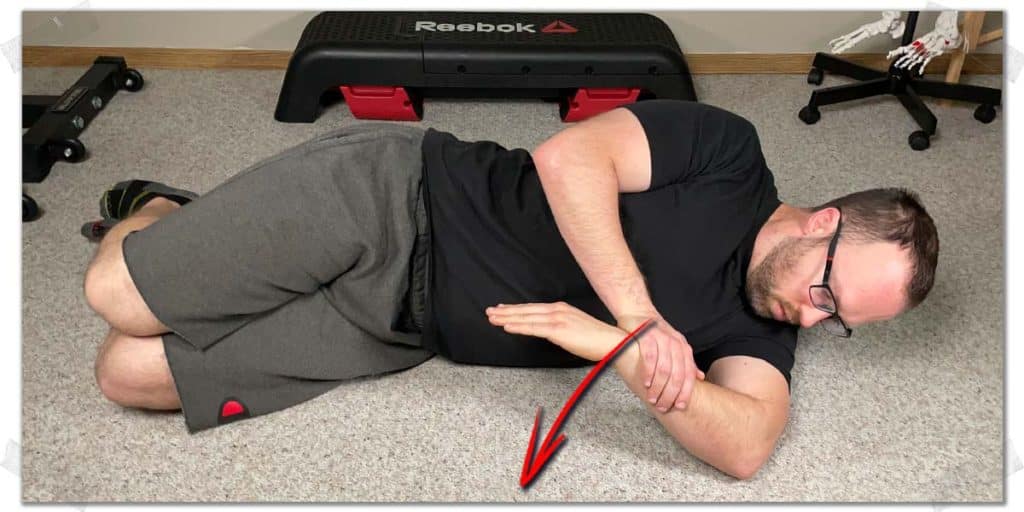
Here’s how to do it:
- Lay on the side of your sore shoulder.
- Position the upper arm of your sore shoulder so it’s perpendicular to your torso.
- Bend the elbow of that arm to 90 degrees.
- Place the hand of your top arm on the wrist of your bottom arm.
- Rotate your bottom downwards. Once it’s gone as far as it can on its own, press it down further using your other hand.
- Press down until you feel a strong (but not painful) stretching sensation in your shoulder.
- Hold this position for a minimum of thirty seconds. Repeat as many times as desired.
Issue 2: Poor scapular mechanics
Even with perfect tissue mobility, you’re bound to run into shoulder pain with the pullover if your scapular (shoulder blade) mechanics aren’t on point.
The pullover requires a certain amount of what’s known as scapulohumeral rhythm throughout the movement. This is the fancy way of saying that a specific movement ratio between the scapula and the humerus (upper arm bone) must occur with specific shoulder movements.
As the arm begins to raise overhead, the shoulder blade must swing upwards so that the head of the humerus doesn’t hit the acromion process (the roof of the shoulder blade) on the way up. When the shoulder blade fails to swing upwards during overhead movements, the humeral head can pinch the subacromial bursa or supraspinatus tendon of the rotator cuff, leading to conditions such as bursitis and shoulder impingement.
Pro tip: When it comes to overhead movements and general shoulder movements in the gym, don’t follow the “keep your shoulders pulled down and back” nonsense that many lesser-informed trainers dogmatically preach. Doing so is a great way to generate shoulder impingement.
How to have perfect scapular mechanics
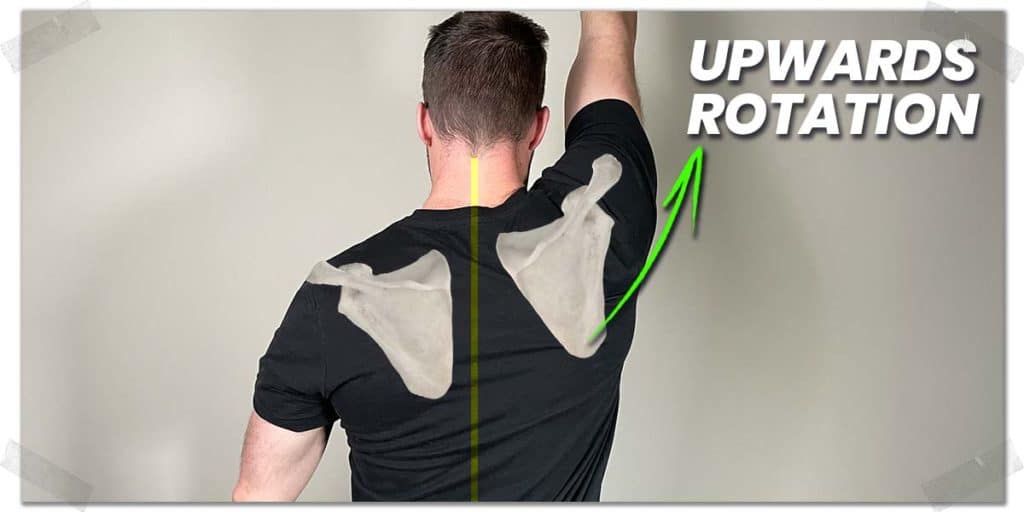
It’s a bit tricky to explain in a blog article, but the key to having ideal scapular mechanics with the pullover (barbell or dumbbell) essentially all starts by not keeping your shoulder blades pulled down and backwards. Aim to do the opposite instead; if you can avoid keeping your shoulders pulled down and back, you’ll be well on your way to having adequate mechanics.
Related article: Horizontal vs Vertical Rows: Differences & Benefits of Each
As you lower the weight behind your head, make sure you’re gently shrugging your shoulders upwards while simultaneously letting them rotate upwards to ensure you’re not at the risk of shoulder impingement.
Basically, it should feel like your shoulders are doing the opposite of staying tucked down and pulled together. Don’t aggressively do the opposite; instead, let these movements happen. The further back you drop into the pullover (the weight going behind your head), the more your shoulder blades should rotate upwards.
Issue 3: Using excessive range
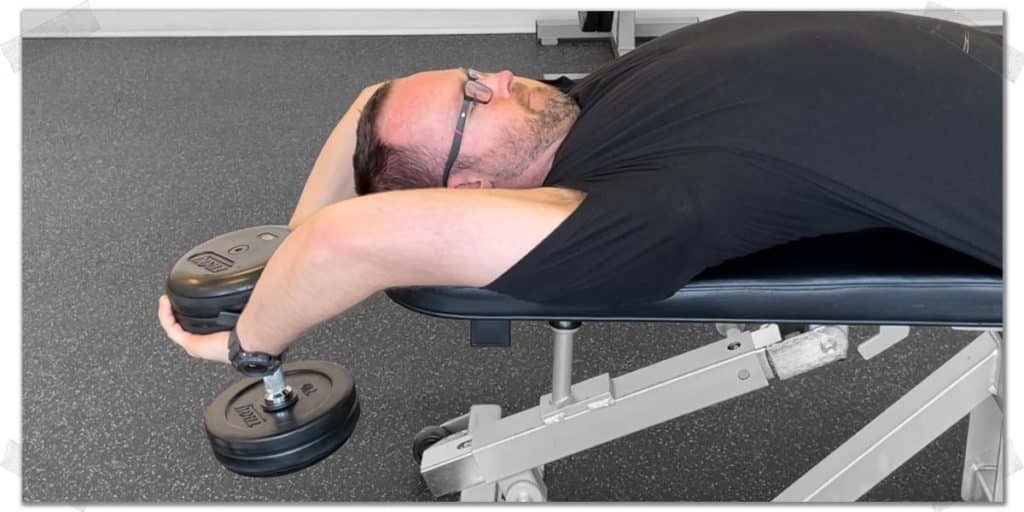
The pullover exercise is all about challenging the range of motion of your upper body as much as possible while respecting what the shoulder joint and surrounding muscles can tolerate.
Even if you have ideal mobility in your pecs, lats, and triceps, you still need to respect the range of motion that you put your shoulders through.
If you’re new to the pullover and just getting a feel for the movement, or you simply lack confidence when performing this exercise, using a rather large range of motion when bringing the weight behind your head can get you in trouble if you’re not quite sure where to stop the movement.
It’s easy for beginners or those new to the movement to use a range of motion that can irritate the shoulders, even if you don’t feel the irritation occurring in the moment.
When it comes to your range of motion, don’t automatically think, “if some range is good, then more must be better.” Yes, while you want to use the largest range of motion appropriate for your body, don’t be in an absolute rush to get there if you’re lacking any sort of confidence. A lack of confidence combined with excessive range of motion might be a recipe for tweaking your shoulder, chest, tricep, etc.
How to find the ideal range of motion
It can take time and multiple sessions to really know how much range of motions your shoulder joint or surrounding muscles can tolerate; be patient.
Start by playing it conservatively if you feel that you might be using too much range of motion during the exercise but don’t know how to find the ideal amount. Use a small range of motion and a lighter load. If things feel fine throughout that particular session, bump the range of motion up a wee little bit for the next session.
Repeat this process until you’ve found a range of motion that you’re both confident with and feel physically comfortable with for your upper body.
Remember: You’ve got the rest of your life ahead of you to keep training, so you don’t have to figure everything out in a single workout session.
Issue 4: Excessive resistance
It feels good to train heavy. I love the feeling as much as the next lifter. But you can’t let this love blind you to the need for training smart. After all, the spirit is willing, but the body is weak.
Whether you’re doing your pullovers with a barbell, a single dumbbell, or two dumbbells, you need to ensure your poundages are dialled into an appropriate amount. I can’t tell you specifically what that is, as there are far too many variables at play, ranging from your training goals, training age, overall health, tissue mobility, previous injuries, etc.
But I can provide some general tips that will work for any situation where you’re doing pullovers that are relatively heavy for your abilities:
Tip 1: The heavier you go, the more warmed up you should be
This really should go without saying, but I see this mistake being made all too often. Heavy loads are demanding on the joints, tendons, muscles, and other tissues of the body. Take the time to ensure that your body is ready for the demands you’re going to ask for it.
Tip 2: The heavier you go, the more you MUST control the movement
Momentum is real, and the heavier your pullovers are, the more the weight will try to control you. When it comes to heavy lifting, slight deviations in your movement can take you for a ride, leading to tweaks, strains, and injury. So, you must make an intentional effort to control every aspect of your movement during the exercise.
Controlling the movement with a heavy load in your hands is accomplished by slowing the movement down throughout all phases of the exercise — especially on the eccentric (downward) phase!
Remember: the heavier your load, the less margin for error there is with your movement. The heavier you go, the slower the movement should be.
Tip 3: Know how to bail out of the movement, if needed
If or when a lift goes wrong on a heavy movement, you need to know how to bail out of it safely; trying to “save” a repetition that has gotten a bit out of control can be a recipe for disaster.
If the weight is behind your head and you’ve lost some portion of control of the movement, bail out of the exercise by dropping the weight behind you onto the ground. This typically only needs to be done when performing near-maximal or maximal weight, but knowing how and when to do so can be the difference between tearing or straining a muscle, spraining a joint, or avoiding catastrophe.
So, if something goes wrong, and the weight isn’t directly on top of your face/head, bail out of the exercise and let go of the weight.
Bonus tip: previous injury
Shoulders can take a beating throughout life, so if you have a history of injury to your shoulder(s), you need to keep in mind that it can alter how your shoulder, chest or upper extremity tolerates the pullover. This applies regardless of whether the injury was significant, small, a long time ago, or somewhat recently.
An injury — even when it is otherwise fully recovered — can alter the movement abilities of the muscles and joint itself.
What this means for you (if you have a history of any shoulder injury) is that you’ll need to keep a bit of a closer eye on how it’s feeling and moving during your pullovers. It might never be an issue for you again, but being mindful of the area and giving it a bit of extra attention when needed is a smart move to make.
Final thoughts
If I ran the world, everyone would incorporate the pullover, or some variation of it, into their training regimen. But I’d also make sure everyone would perform this beauty of a movement without any shoulder pain or dysfunction.
But the best I can do is to encourage you to take the tips and insight in this article and use them to point you in the right direction for getting your shoulder pain under control so you can get back to performing one of the greatest exercises of all time.

Hi! I’m Jim Wittstrom, PT, DPT, CSCS, Pn1.
I am a physical therapist who is passionate about all things pertaining to strength & conditioning, human movement, injury prevention and rehabilitation. I created StrengthResurgence.com in order to help others become stronger and healthier. I also love helping aspiring students and therapists fulfill their dreams of becoming successful in school and within their clinical PT practice. Thanks for checking out my site!

